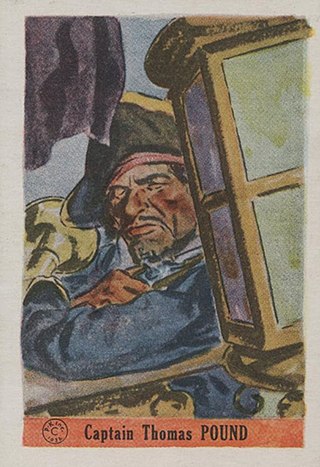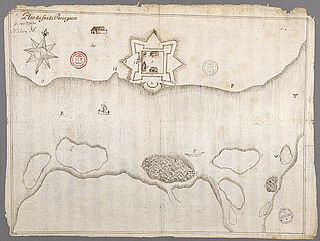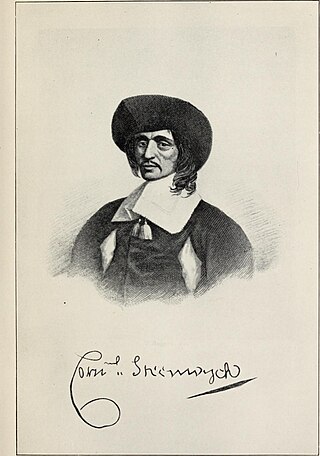Related Research Articles

The Netherlands began its colonization of the Americas with the establishment of trading posts and plantations, which preceded the much wider known colonization activities of the Dutch in Asia. While the first Dutch fort in Asia was built in 1600, the first forts and settlements along the Essequibo River in Guyana date from the 1590s. Actual colonization, with the Dutch settling in the new lands, was not as common as by other European nations.

Castine is a town in Hancock County in eastern Maine, United States. The population was 1,320 at the 2020 census. Castine is the home of Maine Maritime Academy, a four-year institution that graduates officers and engineers for the United States Merchant Marine and marine related industries. Approximately 1000 students are enrolled. During the French colonial period, Castine was the southern tip of Acadia and served as the regional capital between 1670 and 1674.

Bristol, known from 1632 to 1765 as Pemaquid is a town in Lincoln County, Maine, United States. The population was 2,834 at the 2020 census. A fishing and resort area, Bristol includes the villages of New Harbor, Pemaquid, Round Pond, Bristol Mills and Chamberlain. It includes the Pemaquid Archeological Site, a U.S. National Historic Landmark. During the 17th and early 18th century, New France defined the Kennebec River as the southern boundary of Acadia, which put Bristol within Acadia.

Acadia was a colony of New France in northeastern North America which included parts of what are now the Maritime provinces, the Gaspé Peninsula and Maine to the Kennebec River. During much of the 17th and early 18th centuries, Norridgewock on the Kennebec River and Castine at the end of the Penobscot River were the southernmost settlements of Acadia. The French government defined the borders of Acadia as roughly between the 40th and 46th parallels on the Atlantic coast. It was eventually divided into British colonies. The population of Acadia included the various indigenous First Nations that comprised the Wabanaki Confederacy, the Acadian people and other French settlers.

John Leverett was an English colonial magistrate, merchant, soldier and the penultimate governor of the Massachusetts Bay Colony. Born in England, he migrated to Massachusetts as a teenager. He was a leading merchant in the colony, and served in its military. In the 1640s he went back to England to fight in the English Civil War.
Sir Thomas Temple, 1st Baronet was an English proprietor and governor of Acadia/Nova Scotia (1657–70). In 1662, he was created a Baronet of Nova Scotia by Charles II.

Thomas Pound was an English Royal Navy officer who turned pirate and was briefly active in the coastal waters of New England during 1689. Caught and convicted of piracy, his crimes were forgiven and he later rejoined the Royal Navy.
Claude de Saint-Étienne de la Tour was born in the province of Champagne, France and came to Acadia in 1610 after suffering heavy losses as a ship's captain.

Fort Pentagouët was a French fort established in present-day Castine, Maine, which was the capital of Acadia (1670–1674). It is the oldest permanent settlement in New England.

Cornelius Steenwyck served two terms as Mayor of New York City, the first from 1668 to 1672 and the second from 1682 to 1684.

Jurriaen Aernoutsz was a Dutch colonial navy captain, who briefly conquered the capital of Acadia, Fort Pentagouet in Penobscot Bay and several other villages, and renamed the colony New Holland during the Franco-Dutch War.

New Holland was a colony established by Dutch naval captain Jurriaen Aernoutsz upon seizing the capital of Acadia, Fort Pentagouet in Penobscot Bay, and several other Acadian villages during the Franco-Dutch War. The Dutch imprisoned the Governor of Acadia Jacques de Chambly. The French and native allies under the command of St. Castin regained control of the area the following year in 1675, however, a year later the Dutch West India Company appointed Cornelis Steenwijck, a Dutch merchant in New York, governor of the "coasts and countries of Nova Scotia and Acadie." The formal Dutch claim to Acadia (1676) was finally abandoned at the end of the war with the Treaty of Nijmegen in 1678.

Fort William Henry is located in the village of New Harbor in the town of Bristol, Maine. The fort was, in its time, the largest in New England. The fort was originally built in 1692 but destroyed four years later by New France in the Siege of Pemaquid (1696). A reconstruction was built in 1908. The fort was added to the National Register of Historic Places on December 1, 1969. Fort William Henry is now operated as a museum about the fort's history.

The Acadian Civil War (1635–1654) was fought between competing governors of the French province of Acadia. Governor Charles de Saint-Étienne de la Tour had been granted one area of territory by King Louis XIV, and Charles de Menou d'Aulnay had been granted another area. The divisions made by the king were geographically uninformed, and the two territories and their administrative centres overlapped. The conflict was intensified by personal animosity between the two governors, and came to an end when d'Aulnay successfully expelled la Tour from his holdings. D'Aulnay's success was effectively overturned after his death when la Tour married D'Aulnay's widow in 1653.
Cornelius Andreson was a Dutch pirate, privateer, and soldier. He is best known for attacking English traders off Acadia and for serving in King Philip’s War.
Peter Roderigo was a Dutch pirate, privateer, and soldier. He is best known for attacking English traders off Acadia and for serving in King Philip’s War.
Thomas Hawkins was a pirate briefly active off New England. He was known for sailing with Thomas Pound.
Thomas Henley was a pirate and privateer active in the Red Sea and the Caribbean.
John Graham was an English pirate active off New England and the African coast.
George Peterson was a pirate active off New England and Nova Scotia and in the West Indies.
References
- ↑ Dow, The Pirates of the New England Coast, 1630-1730, page 44-45
- Dow, George Francis; Edmonds, John Henry (1923). The Pirates of the New England Coast, 1630-1730. Salem MA: Marine Research Society. ISBN 9780486290645 . Retrieved 14 July 2017.
- Roberts, William I., 3rd (1979) [1966]. "Rhoades, John". In Brown, George Williams (ed.). Dictionary of Canadian Biography . Vol. I (1000–1700) (online ed.). University of Toronto Press.
{{cite encyclopedia}}: CS1 maint: multiple names: authors list (link) CS1 maint: numeric names: authors list (link)